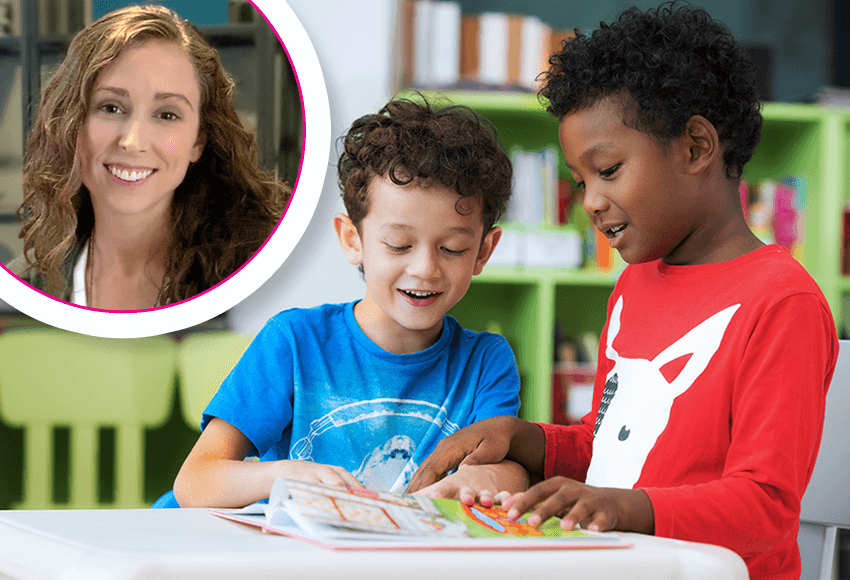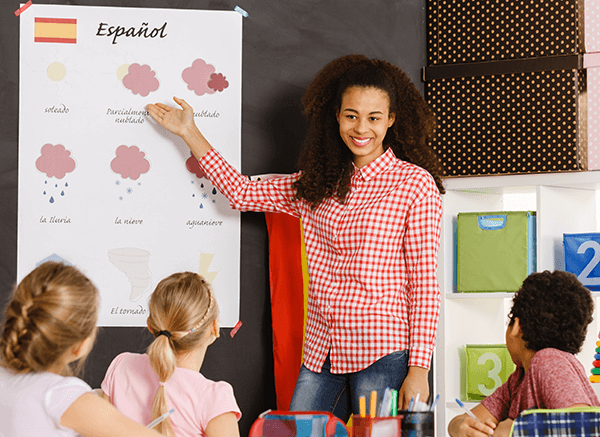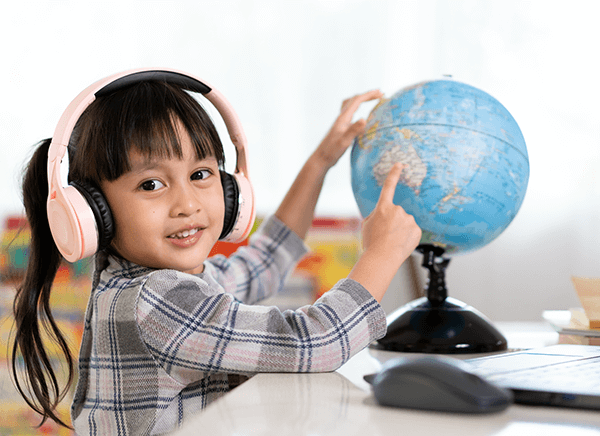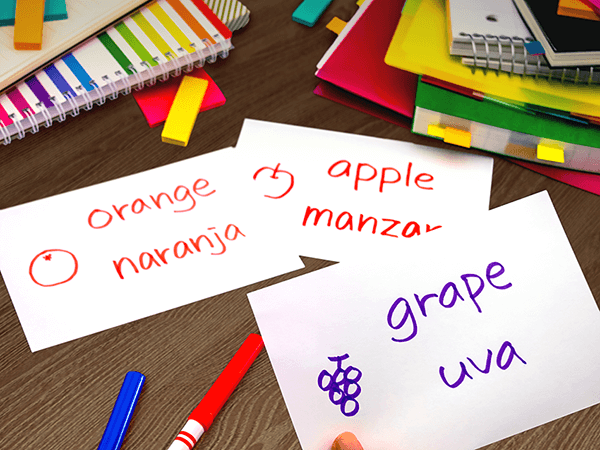Learning Panel Interview: Meet Bilingual Expert Jenna Vislisel
Feb 22nd 2022

Developing a dual language skill set has benefits that can last a lifetime. Jenna Vislisel, an expert on bilingual education and the founder of language learning resource Bilingual Balance, joins our learning panel to give insight into the best practices for teaching students a second language, both at home and in the classroom. Combining her expansive knowledge of teaching and bilingual practices, Jenna has endless resources to help foster a love for language learning in children of all ages and grade levels. Learn more about Jenna and how she integrates a second language into daily routines to help construct biliteracy skills in kids!
Q: What benefits does bilingual instruction provide to students?

A: Bilingual instruction provides so many important benefits to students! Children who are already learning the minority language at home will further develop and strengthen their language skills at school. Students who don’t already speak the minority language at home gain the extraordinary gift of a new language.
All students benefit from increased language proficiency. Research shows that children will grow more in both languages if they are able to learn in both their native and second language. Bilingual education gives students the opportunity to become biliterate—learning to read and write in both languages. Furthermore, learning another language is tied closely to learning about the cultures of the people who speak it, so students in bilingual programs also gain important multicultural competency.
Finally, bilingual school programs provide a quality and quantity of language instruction that can’t be matched by other resources like tutors, daycare providers, or language courses. Immersion students reach high levels of language proficiency, and research shows they’ll find it easier to add on a third language when they choose. There are countless lifetime benefits—cognitive, social, emotional, and economic—to being bilingual!
Q: What are your favorite resources to support emergent bilingual students?
A: Top resource picks for emergent bilingual students should be fun, engaging, and interactive. In our home we use a variety of books, songs, poems, games, and activities in both of our languages, and we’re always looking for new favorites as my own children grow and their interests change. We select high-quality games, puzzles, and open-ended toys that promote language learning through plenty of social interaction. We also love when we find a resource that can be used in both languages!
In my classroom and my home, our favorite resource choice would have to be books. Books can help kids learn about anything they can imagine! Whether they are read aloud by a teacher or parent, or read by the children independently, books can’t be matched for language learning. They provide new vocabulary, stimulate reading skills, and help children develop a lifelong love of reading. Homes and classrooms should be filled with a great variety of children’s books—bilingual, or in either language. Above all else, emergent bilingual students need fun, quality resources that help motivate them to love learning in two languages.
Q: What resources do you find most helpful for serving children who are learning primarily in a second language (i.e., English)?
A: Books, books, and more books! Caregivers and teachers need to surround their language learners with diverse, interesting texts. Children’s books can be found for any topic we teach, and the wide range of themes expose kids to rich, varied language. From biographies and informational texts to books on character education, our children need books that cover a multitude of subjects. Whether we’re building background, teaching new vocabulary in context, helping students make connections to prior learning, sparking the curiosity of budding writers, or building interest in a new language topic, quality children’s literature applies to all content areas and to all ages of language learners.
I also suggest educational resources that can help make language input comprehensible and enjoyable! We can choose music, puppets, learning games, visuals, and real objects (or manipulatives) to help our language learners understand our lessons. We want to provide hooks (such as a catchy song, a photo-card of a new word, or an interactive notebook) for kids to stay engaged in the lesson. Hands-on learning is key! The more attractive the lesson theme or activity, the greater the engagement and learning outcome.
Q: What resources do you find most helpful for serving children who are learning a second language outside of the language that is used for their primary instruction?
A: When children are learning another language at home that isn’t used for instruction at school, parents can support their learning with a variety of tools. Helpful resources like books, music, and games for younger children can help the family stay consistent with their minority language use. We want our children to value their home language, and to make sure they have exposure and a need for using the language each day. Both can happen when we surround children with opportunities to practice their language skills with educational resources.
As children grow, parents can also use resources like workbooks, podcasts, audiobooks, interactive websites, and apps for minority language learning. All of these resources, when in the target language, provide valuable language input and practice for the child. They help provide daily experiences in the language through fun and meaningful family interaction, like reading about a favorite topic, doing a puzzle, or enjoying a podcast in the car together. The more resources we can have in our bilingual parenting bag of tricks, the better!
Q: In addition to educational resources, what are other ways to practice bilingual skills on a daily basis?

A: Parents can help provide learning opportunities for children in both languages each day. While practicing the home language comes naturally, it may take more creativity to prioritize practicing the second language. However, parents can incorporate the target language in so many helpful ways. Most importantly, caregivers can integrate the target language into a daily routine. Whether it’s getting ready for bed, cooking and eating dinner together, or reading time each day, children will come to expect and look forward to time spent using the target language. Ideally, you’ll also get quality bonding time together by making memories in the target language.
There are also a variety of activities that can be used to supplement language learning. Some of these can include intentionally involving kids in fun everyday tasks, making calls and writing letters to friends and family who speak the language, family outings to explore diverse locations like zoos or markets, community events and classes, or language playdates with other speakers of your language. Language learning takes time and dedication, yet there are many opportunities each day for weaving in second language practice!
Q: Do you have any tips for parents who would like to start incorporating a second language into their child’s learning?
A: First and foremost, I recommend parents and caregivers think through their goals for their child’s language fluency and make a thoughtful plan for meeting them. Whether you’re going to use the second language during mealtimes, learn together on the weekends, or enroll your child in a bilingual school program, a plan will help map out the details of why you’d like your child to learn another language and how you’ll make it happen.
In addition, parents can take advantage of daily routines to consistently integrate target language into the child’s day. Again, this could be getting ready in the morning, mealtime, or daily playtime. Rituals are so helpful for providing everyday opportunities to teach and practice language. As you think about your daily routines, make sure to prioritize reading with the child in the target language each day.
Deepen your child’s learning by discovering appealing and age-appropriate music, videos, and other outside resources that can help motivate them. As you add language learning resources to support your child’s skills, seek out support for your bilingual parenting as well. It can make a difference to find websites, bilingual parenting books, or other like-minded people to keep you inspired for teaching your child a second language. Bilingual Balance can be one your partners on the journey!
Lastly, I encourage you to make second language learning fun for both you and your child. Incorporate play-based learning, hands-on activities, and quality educational resources to enjoy connecting with your child in the target language.
Q: Do you have any tips for parents whose children are learning primarily in a language that is different from their home language?

A: To start, I would advise parents to keep cultivating and developing the language you use at home. Set your child up for success by stimulating their at-home learning in whatever language you speak. This could be through reading books to them daily, interacting as you go about everyday activities, singing songs, and playing together. Using your native language—or the language you’re most comfortable with—is important for your child’s cognitive and academic growth. Keep in mind that research shows that a strong foundation in the first language is connected to successfully learning a second language.
Next, look for small ways to incorporate and encourage your child’s second language learning. Even a little bit of a daily second language practice can go a long way in supporting your child’s efforts at school. Think about their age and interests, and seek out desirable ways to practice the language. Whether it’s a big activity like visiting a cultural destination to learn more about the target language, or a small activity like playing a game or doing a science experiment, show your child that you value and support their bilingualism. Remember that language learning is a long journey, and your child will need your patience and encouragement along the way.
Q: How do you showcase the value of multiple languages in your classroom/learning environment?
A: One way to showcase the value of multiple languages in the classroom is to intentionally display them. Especially in a bilingual classroom, children should be surrounded by print in both languages, from classroom object labels or bulletin boards to student work and class rules. Our students should know that both languages are important by seeing them wherever they look. Moreover, a print-rich environment environment encourages language and literacy development.
At the beginning of the year, we can learn about our students and the amazing languages they speak through books and activities. We want students to know that we value multilingualism and that it enriches our lives! We can do this by speaking positively about our students’ languages, encouraging them to actively use them at school and at home, and looking for ways to incorporate their unique languages and cultures into classwork.
Finally, we can choose to promote multilingualism, especially with parents and caregivers! We can ask parents (or other family members) to be guests in our classroom, reading books in their language, and teaching about unique cultural traditions. There are so many incredible advantages to being multilingual, and as teachers we can educate coworkers and parents about the value of knowing more than one language. We should encourage parents and caregivers to speak their languages to their children, allowing them to connect to their relatives and heritage while also broadening their horizons!
Q: What/who inspired you to become a teacher/educator?
A: My mom was absolutely my inspiration to become a teacher. She taught a variety of age levels, but most of her career was spent in her perfect niche—preschool and kindergarten. She has a natural gift for teaching and interacting with children. Her students adored her, and it brought her so much joy to sing, play, and learn with them each day. They learned so much more than they realized because of her incredible knowledge of early childhood development. Her calling to work with young children shines through when you see her with kids, even now with her grandchildren.
As a child, I played school more than anything else, trying to emulate my teacher mom. I loved setting up a classroom of stuffed animals, writing my class list, checking in library books, while singing and reading aloud to my pretend students. My mom’s enthusiasm for shaping her students and the ways in which she fostered a love for learning at home has inspired me to be the kind of teacher she was for countless students during her remarkable career.
Q: What do you love most about teaching?
A: The students I’ve worked with are definitely my reason for teaching and what I love most about being a teacher. Like my mom, I’ve learned that my true calling working with children. Each child is so unique, having a distinct family and home background, and I love getting to know them all. It’s so important to me to get to know their individual personalities, strengths, gifts, and interests. I love using that information to differentiate my instruction and plan fun and engaging lessons, especially ones that I know the kids are going to love.
Seeing my students’ eyes light up for a silly math song and dance, a new science activity, or a creative story that they can’t wait to write makes the hard days worth it. I love teaching young children and seeing them grow in all content areas, but especially in language and literacy skills. The pride they have in mastering a new reading strategy or the enthusiasm they get in gaining confidence in speaking their second language makes my teacher-heart happy.
Q: What was your favorite subject to learn growing up?
A: I’ve always loved language and literacy, so reading and language arts classes were my favorite subjects as a child. I loved learning new vocabulary, studying grammar, and writing imaginative stories. When I reached high school and could take Spanish classes for the first time, I absolutely fell in love with them! I would read ahead to learn more, wait impatiently through my other classes to get to Spanish, and even became a teacher’s assistant my senior year.
It’s no surprise that I went on to study Spanish and elementary education, and that I’ve only taught in bilingual programs! When I decided to get my master’s degree, it was an. easy choice to become a K–6 reading specialist. Teaching young students to read and write in both Spanish and English is my joy. Even now on Bilingual Balance, you’ll find most of my posts are centered around language learning and literacy development in kids. I’m passionate about partnering with parents and teachers to make language learning—and learning to read and write in two languages—enjoyable and meaningful for kids.
Q: What is your favorite Carson Dellosa Education resource?
A: I highly recommend Carson Dellosa’s bilingual Keepsake Stories collection. All three of my children are enamored with fairy tales, and Carson Dellosa Education has so many favorites to choose from! My children love the simple text, charming illustrations, and will often choose these fairy tale stories to be read aloud over and over again. Now that my older two children are reading independently, they can also choose to read the Keepsake Stories books by themselves, or to their younger sister.
The parent and teacher in me loves that each one is bilingual so we can choose to read it in English, in Spanish, or both if we’d like! It’s like having two books in one, and perfect for dual language classrooms where students are learning both languages. Each time we read one, there are new phrases or keywords we can focus on for vocabulary development. Our current favorites are The Three Billy Goats Gruff, Los Tres Chivitos, The Day It Rained Buñuelos, and El Día Que Llovió Buñuelos. With so many fun options, you’re bound to find a new favorite for your children or your class.

